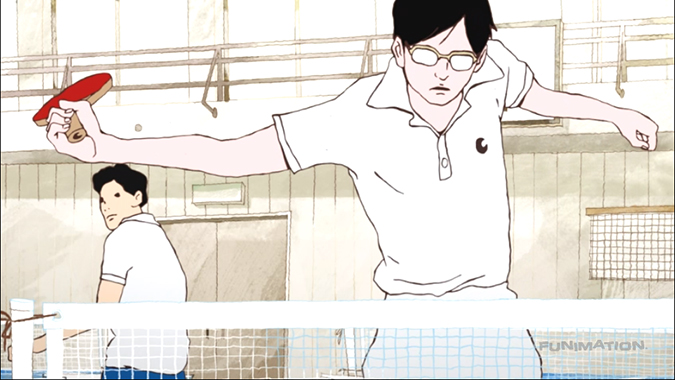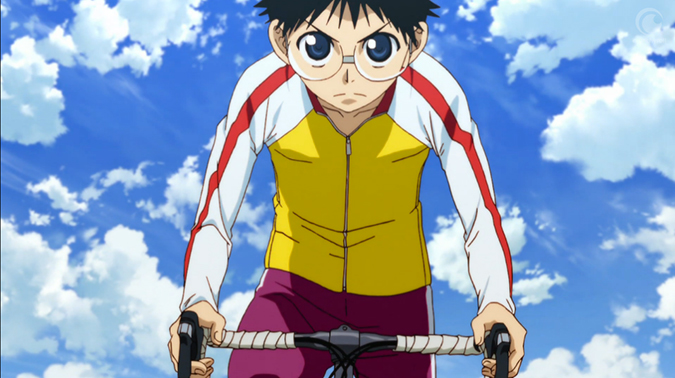It’s a good time for sports anime. Yowamushi Pedal is set to return in the fall after an initial 38-episode run, while volleyball series Haikyu!! is finally kicking off its first big tournament story arc. The Free! juggernaut continues to roll onward, drawing in a variety of fans in its target demographic and beyond. The genre is even being used as a sandbox for unique animation styles, exemplified by Ping Pong: The Animation. Here in the US, often seen as a difficult market for sports shows, jerseys from various fictional teams can be seen in increasing numbers at anime conventions. What is it about this generation of titles that sees the genre in such excellent health, especially on our side of the Pacific?
I can’t possibly imagine how a show about competitive swimming found so many female fans.
Quite a lot of things, actually. Writers and character designers have been making deliberate (and increasingly successful) attempts at appealing to a broader mix of male and female viewers. Animation has gotten more impressive over the years, a vital improvement for a genre that relies on the fluid motions of skilled competitors. Watch Kuroko’s Basketball back to back with 90’s classic Slam Dunk if you want a stark visual demonstration of how things have changed over time. Whether or not you like the new style of character design, it’s clearly optimized for bringing in viewers with an affinity for dreamy dudes. Combine that with some solid action sequences and you’ve got something for just about everyone.
The simulcast method of distribution has also helped things here in the US. Sports anime and manga have never really had much trouble finding an audience in Japan, but things were far less simple for American licensors back when physical releases were the only option. Some notoriously bad sales numbers made the big hitters reasonably wary of the genre, and rightly so. Putting a series out on disc with a full English dub is expensive, and frequently not worth it for a niche title. By comparison, it’s much less of a risk to put a series up online with subtitles, especially for a subscription-based service like Crunchyroll or Funimation. Because it’s less of a financial risk, we get more sports series, and the genre has a chance to find more viewers. As a piece of purely anecdotal evidence, I’ve never bought a physical release of a sports anime, but I’ve gotten hooked on several after watching an episode or two online.
Speaking of watching things online, GO WATCH PING PONG. Do it now.
It’s not entirely surprising that the sports genre is starting to find a foothold in the US. Much of the over-the-top, special-technique-shouting, underdog-versus-champ appeal of shonen action shows is on full display, but with one unexpected advantage: believability. It seems absurd to bring up realism when talking about genres where characters have near-superhuman abilities, but it’s actually quite important when it comes to holding an audience’s interest.
We’re willing to take a lot of things at face value when it comes to characters’ unique abilities. We accept that Onoda can keep up with experienced bicycle racers for the same reason we accept that Goku gets stronger when he yells a lot and turns his hair yellow: we like thinking about what it would be like to have special powers of our own. Where realism comes into play is in how the characters use those abilities, particularly in how they deal with their enemies. It’s impossible to count the number of time an action anime hero has let the bad guy live to return in another story arc, all while the audience screams, “Just SHOOT the bastard!” Because some villains are too good to get rid of, writers have to jump through all kinds of ridiculous hoops to stop the protagonist from killing them, even when that’s what any rational person would do.
If you watched Yowapeda, you now have the “Love Hime” song stuck in your head. You’re welcome.
Sports anime avoids this classic problem by way of its very nature. Unless you’re making a series about gladiators or bullfighters, sports are an inherently non-lethal form of conflict. It makes sense for a defeated rival to come back for a rematch because that’s how sports work in real life. As a result, the viewer doesn’t have to hold back the obvious questions that come up when the good giant robot pilot fails to finish off the bad giant robot pilot. Instead, we can just sit back and enjoy the clashes between the heroes, their rivals, and their mutual archenemies. This isn’t to say that sports series are inherently better at storytelling than their action counterparts, simply that they have one less hurdle to clear. In a world of production deadlines that offer limited time for revising a script, that’s certainly a significant advantage.
I doubt sports anime will ever truly take off in the US, if only because it’s forced to compete with the appeal of watching real teams on live television. Nevertheless, it’s a genre filled with exciting and addicting shows, and the constant search for new source material has given some otherwise obscure sports a chance to shine. Now if only I could talk Japan into making a series about Formula One racing…
Kawaii Overthink is written by Paul Jensen. You can follow his ramblings about anime and manga on Twitter. Check back every Wednesday for new articles.


